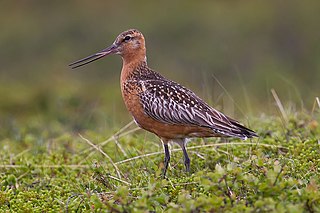
The bar-tailed godwit is a large and strongly migratory wader in the family Scolopacidae, which feeds on bristle-worms and shellfish on coastal mudflats and estuaries. It has distinctive red breeding plumage, long legs, and a long upturned bill. Bar-tailed godwits breed on Arctic coasts and tundra from Scandinavia to Alaska, and overwinter on coasts in temperate and tropical regions of Australia and New Zealand. The migration of the subspecies Limosa lapponica baueri across the Pacific Ocean from Alaska to New Zealand is the longest known non-stop flight of any bird, and also the longest journey without pausing to feed by any animal. The round-trip migration for this subspecies is over 29,000 km (18,020 mi).

The silver-ground carpet is a moth of the family Geometridae. The species was first described by Michael Denis and Ignaz Schiffermüller in 1775. It is common throughout the Palearctic region including the Near East and North Africa.It is found in a variety of different habitats and occurs, for example, in humid forests, moorland and shore areas, on embankments or on unimproved grass meadows and heathlands as well as in gardens.

Johan Wilhelm Zetterstedt was a Swedish naturalist who worked mainly on Diptera and Hymenoptera.

Diapensia lapponica, the pincushion plant, is a plant in the family Diapensiaceae, the only circumboreal species in the genus Diapensia, the others being mainly in the Himalaya and on mountains in southwestern China. This species likely became circumboreal-circumpolar [Arctic–alpine] after it jumped to arctic habitat from North China and Russia. The most likely candidate for ancestor is a white-flowered D. purpurea The plants grow on exposed rocky ridges that are kept free from snow by high winds. Diapensia lapponica is extremely slow and low-growing and cannot compete with plants that overtop it. The plant is very sensitive to higher temperatures and so is often in misty foggy habitat. It usually dies when transplanted to lowland gardens and so this is not recommended. Cold-treated or wild and winter-collected seed will germinate indoors. The seed and leaves are high in lipids.
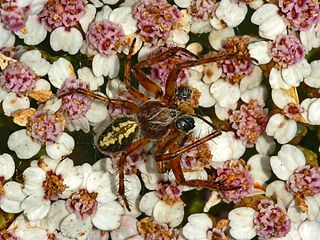
Aculepeira ceropegia, the oak spider, is an orb-weaving spider species belonging to the family Araneidae.

Aculepeira is a genus of orb-weaver spiders first described by R. V. Chamberlin & Wilton Ivie in 1942.

Dactylorhiza majalis subsp. lapponica, the Lapland marsh-orchid, is an orchid native to parts of Europe and Siberia, including the Pyrenees, Alps, and Carpathians and across middle Europe, Scandinavia, and European Russia
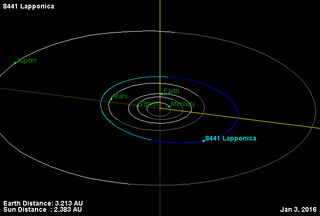
8441 Lapponica, provisional designation 4008 T-3, is a background asteroid from the Florian region of the inner asteroid belt, approximately 4.5 kilometers in diameter. It was discovered on 16 October 1977, by Ingrid and Cornelis van Houten at Leiden, and Tom Gehrels at Palomar Observatory in California. The L-type asteroid has a rotation period of 3.27 hours. It was named for the Bar-tailed godwit, a shorebird also known by its Latin name Limosa lapponica.

Aculepeira carbonarioides is a spider in the orb-weaver family (Araneidae).

The leaf beetle Chrysomela lapponica is found in central and northern Europe feeding on leaves of willows and birch. The adult beetles are about 8 mm long and beetles in different regions can have different colour patterns on their elytra.

Stigmella lapponica is a moth of the family Nepticulidae found in Asia, Europe and North America. It was first described by the German entomologist, Maximilian Ferdinand Wocke in 1862. The larvae mine the leaves of birch.

Harpulina lapponica is a species of sea snail, a marine gastropod mollusk in the family Volutidae, the volutes.

Flora Lapponica is an account of the plants of Lapland written by botanist, zoologist and naturalist Carl Linnaeus (1707–1788) following his expedition to Lapland.
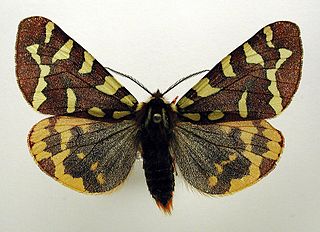
Arctia lapponica is a moth of the family Erebidae first described by Carl Peter Thunberg in 1791. It is found in northern Eurasia and the Arctic part of North America.

The expedition to Lapland, the northernmost region in Sweden, by Carl Linnaeus between May and October 1732 was an important part of his scientific career.

Calamagrostis lapponica, the Lappland reedgrass, is a grass species native to colder parts of the Northern Hemisphere. It has been reported from Scandinavia, Russia, Greenland, Alaska, and every Canadian province and territory except the Maritime Provinces.
Aculepeira talishia is an orb-weaving spider species found in Turkey, Russia, Georgia and Azerbaijan.
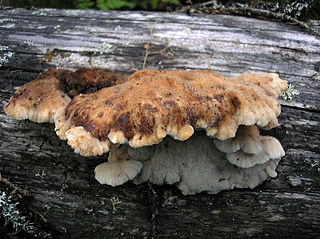
Amylocystis lapponica is a species of bracket fungus in the family Fomitopsidaceae, and the type species of genus Amylocystis. It produces medium-sized, annual fruit bodies that are soft, and have a strong, distinct smell. The fungus is a saprophyte that feeds on coniferous wood of logs lying on the ground, and causes brown rot. It is a rather rare species that only occurs in old-growth forest.

Aculepeira packardi is a species of orb weaver in the spider family Araneidae, which lives in North America, Russia, China and Kazakhstan.

















